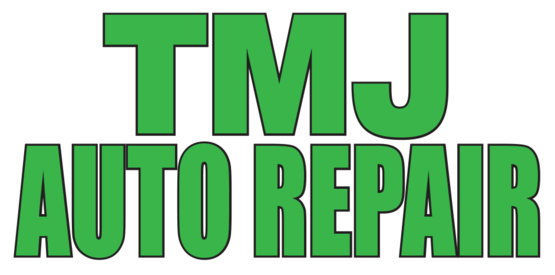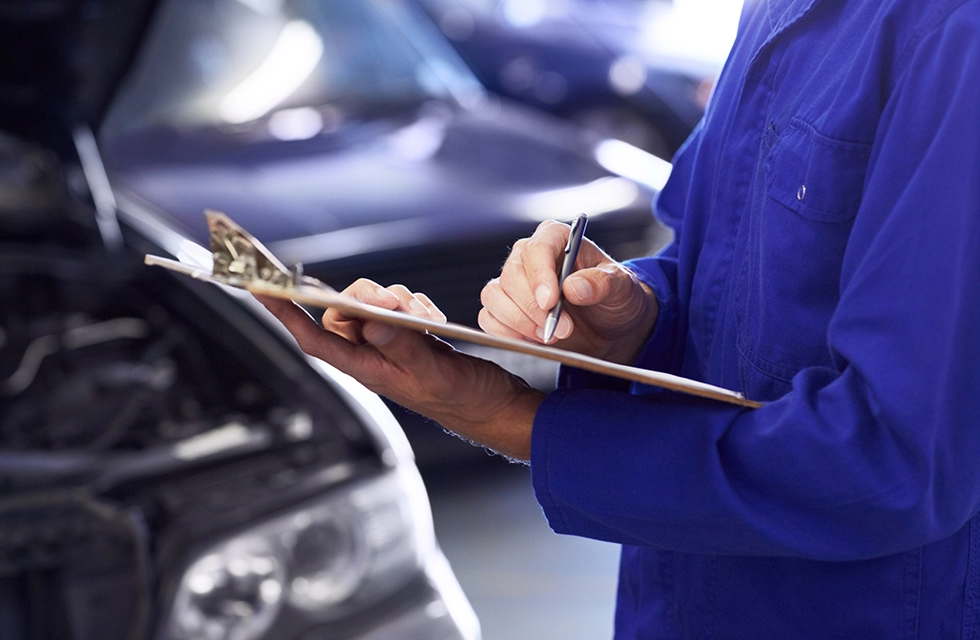This page provides answers to some of the most frequently asked questions about vehicle repair and service. We've thrown in some of our favorite tips and recommendations, too. Please call us or consult our Contact Us page for answers to your specific questions. We are happy to assist you!
Tires
-
How much air should I put in my tires?
Proper inflation is the single most important part of tire care. Check or adjust inflation every few months and always use the inflation recommended by the vehicle manufacturer. Checking air pressure should be standard procedure on any routine visit to your vehicle service center for oil services, tire rotations, or general maintenance and repair.
For do-it-yourselfers you can find this information in your owner's manual, posted on the edge of the driver's door, on a door post, in the center console, or on the inside of the glovebox door. Be sure to check inflation when tires are COLD: when the vehicle has been driven less than a mile or one hour or more after driving. Use a good quality tire gauge. And don't forget to check the spare!
-
Should I rotate my tires?
The main purpose of regularly rotating tires is to achieve more uniform wear for all tires on the vehicle. It is recommended that you rotate your tires at least every 6,000 to 8,000 miles or uneven wear may develop. At strongly tire-oriented facilities this is a service typically done at no additional cost; along with free flat repairs, Nitrogen inflation, and an undercar inspection.
-
Can I drive normally on my spare tire?
Many newer vehicles come equipped with a temporary spare, sometimes called a "donut". These tires are usually much smaller than the other tires on your car. It is important to realize that these spares have far more limitations than a typical tire, including speed and recommended driving distance. No more than 50mph and drive no further than 50 miles on the "donut" temporary spare.
Vehicle Maintenance
-
My check engine or service engine soon light comes on. What should I do?
When you first start your car all the dashboard lights come on as a safety test. These lights will go off when the test is complete. If your light comes on later you need to have it checked by a competent technician familiar with modern diagnostic procedures. This could be a simple problem, but left alone it may result in an expensive repair. Don’t ignore this warning.
-
I have 100,000 mile spark plugs in my car. When will I need a tune-up?
In the traditional sense there is no such thing as a tune-up anymore. Carburetors and distributors with their myriad of parts destined to failure have been replaced with electronic injectors and electronic ignition systems. There is virtually little to wear out.
Aging Ignition wires and spark plugs may continue to function for 100,000 miles but not optimally. The car manufacturer’s boastful claim of 100,000 between tune-ups has little grounding in common sense, and is mostly a marketing ploy. At the price of gasoline these days even a three percent decrease in fuel efficiency is expensive, not to mention ecologically unfriendly. A fresh set of spark plugs any time over 50,000 miles will normally make a noticeable difference.
-
What does it mean if my "check engine" or "service engine soon" light comes on?
There are many sensors and computerized components that manage your vehicle’s engine performance and emissions. When one of these fails, the "check engine" light is illuminated. Although your car may seem to run fine, it is important to have the issue addressed to prevent long-term problems.
-
When should I change my spark plugs?
For maximum fuel economy and peak engine performance, your spark plugs should be replaced every 30 months or 30,000 miles, unless your vehicle is equipped with 100,000-mile platinum tipped spark plugs.
-
With the change of the season and the temperatures, do I need to have my car checked?
It is a good idea to have your coolant checked to determine its freezing and boiling points to verify whether it needs to be changed. Have your air conditioner tested before the summer heats up, it is cheaper to fix before the season gets started.
Vehicle Fluids
-
I see a fluid leak under my car, what is it?
You can identify fluids by their color and consistency:
• Yellowish green, pastel blue or florescent orange colors indicate an overheated engine or an antifreeze leak caused by a bad hose, water pump or leaking radiator.
• A dark brown or black oily fluid means the engine is leaking oil. A bad seal or gasket could cause the leak.
• A red oily spot indicates a transmission or power-steering fluid leak.
A puddle of clear water usually is no problem. It may be normal condensation from your vehicle's air conditioner.
-
I have a leak under my car. How can I tell what is leaking?
The coloring of the liquid identifies the type of liquid. Coolant Fluid is orange or green, Engine fluid is Brown or Black, Transmission Fluid is Red or Pink, Power Steering Fluid is Light Brown, Differential Fluid- Brown. depending on the leak it could mean trouble, don't wait until it's too late!
Vehicle Smells & Sounds
-
I smell something in /around my car, what could it be?
• The smell of burned toast - a light, sharp odor - often signals an electrical short and burning insulation. To be safe, try not to drive the vehicle until the problem is diagnosed.
• The smell of rotten eggs - a continuous burning-sulfur smell - usually indicates a problem in the catalytic converter or other emission control devices. Don't delay diagnosis and repair. • A thick acrid odor usually means burning oil. Look for sign of a leak.
• The smell of gasoline vapors after a failed start may mean you have flooded the engine. Wait a few minutes before trying again. If the odor persists, chances are there's a leak in the fuel system - a potentially dangerous problem that needs immediate attention.
• Burring resin or an acrid chemical odor may signal overheated brakes or clutch. Check the parking brake. Stop and allow the brakes to cool after repeated hard braking on mountain roads. Light smoke coming from a wheel indicates a stuck brake. The vehicle should be towed for repair.
A sweet, steamy odor indicates a coolant leak. If the temperature gauge or warning light does not indicate overheating, drive carefully to the nearest service station, keeping an eye on your gauges. If the odor is accompanied by a hot, metallic scent and steam-from under the hood, your engine has overheated. Pull over immediately. Continued driving could cause severe engine damage. The vehicle should be towed for repair.
-
My car is making a terrible sound, what information will help?
Squeaks, squeals, rattles, rumbles, and other sounds provide valuable clues about problems and maintenance needs. Here are some common noises and their definitions.
Squeal - A shrill, sharp noise, usually related to engine speed.
Click - A slight sharp noise, related to either engine speed or vehicle speed.
Screech - A high-pitched, piercing metallic sound; usually occurs while the vehicle is in motion.
Rumble - a low-pitched rhythmic sound.
Ping - A high-pitched metallic tapping sound, related to engine speed.
Heavy Knock - A rhythmic pounding sound..
Clunk - A random thumping sound.
The more details you can provide us, the better chance of locating the problem quickly. Does the noise occur when the engine is cold or warm? Hot or cold outside, rainy or dry? Does the noise occur while driving or only when parked? These clues help the technician diagnose your problems faster, saving you time and money!
-
I hear an intermittent noise from the front of my car. Do I need to worry about it?
Every noise should be checked by a qualified technician. Use you best judgment, if it sounds bad, get it checked right away. Quick action on a problem can many times save big dollars.
Oil Change
-
How often should I change my oil?
Most car manufacturers say to change your oil every 7,500 miles unless you drive in severe conditions. Severe conditions are defined as dirty or dusty roads, extremely hot or cold climates, a lot of stop and go driving, taking long trips or if you tow a trailer. If you answer yes to any of the severe driving conditions, your vehicle falls into the severe conditions category, or the 3,000 mile oil change interval.
-
What is that milky brown engine oil?
Milky brown engine oil is an indication of coolant in the oil. This can be caused by a blown head gasket (other gasket), a failed transmission cooler, or cracked casings. This condition is very serious and needs to be checked by a professional technician quickly.
-
What is synthetic motor oil?
Synthetic motor oils can be a good choice for high output, turbocharged or supercharged engines, vehicles that are used for towing (especially during hot weather), or vehicles that are operated in extremely cold or hot climates.
Synthetic motor oils, though several times more expensive than mineral-based motor oils, can improve fuel economy and provide longer intervals between changes. They also provide instant lubrication on start-up.
Troubleshooting
-
What should I do if my car starts to overheat?
This is a very serious problem – if your car overheats for too long, you can damage your engine. As soon as possible, find a safe place to pull off the road and shut the engine off! Do not attempt to check the fluid level in the radiator as it can burn you. The best thing to do is have your car towed to a repair shop.
-
What dashboard lights should I worry about and which are just precautions?
Every dashboard light is responsible for notifying the owner of issues that need to be addressed. If any of the following lights are lit you need to have your vehicle looked at: Engine light, Oil light, ABS light, Traction light, Tire Pressure light.
Electrical System
Fuel System
Improving Gas Mileage
-
How can you increase fuel mileage?
To optimize gas mileage, check tires for proper inflation, make sure wheels are in alignment, check and replace filters, change Your oil regularly, keep your engine properly tuned, empty out your trunk of unnecessary items, observe the speed limit. These seemingly minor adjustments to your driving and maintenance habits can save on gas--and money!
Cabin Air Filters
-
What is a Cabin Air Filter?
Cabin air filters filter the air that comes from the outside of a vehicle into the passenger compartment. They were originally designed to remove solid contaminants like dust and soot from circulating inside the vehicle. These filters can now also absorb gases and odors. Cabin air filters may also be known as passenger compartment filters, pollen filters, or dust filters.
-
Why are Cabin Air Filters important?
Air quality is becoming a major concern for many people - outdoors, in our homes, and now even in our automobiles. An estimated 50 million Americans suffer from hay fever and other allergy-related problems.
-
How often should they be replaced?
Vehicle manufacturer recommendations may vary, but the general guideline for replacing cabin air filters is every 12,000 to 15,000 miles, or at least once a year.
-
What happens if they are not replaced at the recommended interval?
In addition to the possibility of unpleasant odors, filters that have been left in service for over 20,000 miles can result in decreased heating and air conditioning performance caused by restricted air flow through the cabin air filter.









